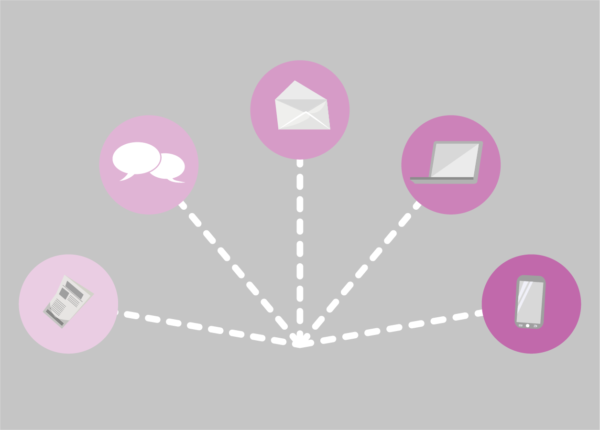
Have you ever heard someone use so many buzzwords your brain feels like it’s going to explode? “We’ve got to reach our digital native, Gen Z audience with snackable content. And we need to leverage AI across the entire buyer’s journey to deliver sufficient value-add. But we need to be transparent. And data-driven. And customer-centric. Any low-hanging fruit here? Let’s ideate.”
Buzzwords are often so overused they become clichés. Yet most buzzwords became popular terms in the first place because they represent a real trend worth exploring.
Take omnichannel for example. Whenever I hear “omnichannel” in a laundry list of other buzzwords, I can’t help but roll my eyes. But the truth is we live in a world with more communication channels than ever before. Customers and business buyers expect to be able to communicate with everyone in their lives, including the companies they interact with, in any of those channels. In other words, the term is used a lot these days because it is actually important.
But don’t just take my word for it, listen to some of the top thought leaders on the subject. I’ve compiled some key insights from them — with minimal eye-roll-inducing buzzwords!
Omnichannel means delivering a seamless experience
In traditional marketing-speak, omnichannel means that we seek to give our customers a seamless and unified shopping experience across all channels.
Today omnichannel isn’t just a technology or shopping play. It’s more broadly the brand experience that a customer has with you across various platforms and channels, at every step of the way. It integrates technology, data, content, and communication across an organization in an effort to deliver a seamless experience to the customer or prospects.
In other words: What your customer experiences over here also matches what they experience over there. When all those touch points are aligned… it’s a powerful thing. And when they aren’t, your customers and prospects end up feeling uneasy and disappointed at the mismatch.
—Ann Handley, Chief Content Officer at MarketingProfs (via her blog)
Omnichannel is about connecting
With so many channels through which customers communicate, it seems like creating a powerful and memorable customer experience is more complicated than ever. Technically, that’s true. But, on the surface, customers want the same things they’ve always wanted, and that is to be taken care of. They may be more demanding. They may want problems resolved faster. But that’s understandable because technology has given us the tools to provide that kind of speed.
And, here is something very important to consider. Customers don’t care if you claim you have omni-channel or multi-channel capabilities. They only care that they can connect with you, the way they want to connect with you, and when they want to connect with you. They go through the channel that’s easiest and most convenient for them. It could be a phone, a desktop computer, a tablet – whatever communication method they are most comfortable with.
—Shep Hyken, Customer Service and Experience Speaker (via Forbes)
Omnichannel and personalization are two sides of the same coin
Today’s organizations are really looking at omnichannel and personalization and saying, “These are the kinds of things we need to be doing for our customers.” Why? They want contextually relevant experiences, they want seamless experiences — which ties nicely to both of these initiatives. What organizations often miss, is the fact that these two initiatives are very much tied together.
Personalization is not about making product or service recommendations anymore. It’s about creating value-oriented, contextually relevant experiences for customers. Omnichannel is about creating consistent experiences for customers. If you really think about it, those two things are very much tied together. The ability to see the customer across channels is both an initiative for omnichannel and personalization, and required to both.
In addition, the idea of creating engagement that is seamless across channels must be personalized for the consumer, otherwise they’re not going to see value in the experience. In other words, it won’t really differentiate your brand.
—Brendan Witcher, Vice President, Principal Analyst at Forrester Research (via Forrester)
Customers have memories, businesses need to have memories too
You can only understand an omnichannel capability by looking at a customer’s interactions through the customer’s own eyes – seeing them and experiencing them as the customer does. And the problem is, customers have memories. Whether you remember them or not, they remember you. They are totally aware of what they said to you or asked of you in one channel, and they carry that awareness with them when they interact with you via any other channel.
This means a company can only be considered to have “omnichannel” capabilities if the history and context of each customer’s interactions in one channel are flawlessly carried over into the next channel, and the next, and the next.
—Don Peppers, Author, Speaker and CX expert (via LinkedIn)
Technology is at the core of every omnichannel and personalization strategy
If you struggle with effective cross-channel communication with your customers and prospects, the good news is that you’re not alone. Recognizing and remembering someone across channels isn’t easy.
It starts with the right technology. You need a centralized system that can bring all of your customer data together to create a single picture of each person. Ideally, that same system can act on the data in each channel, or at least enable your other systems to act on it.
That means that your website and your mobile app can access the data to determine the best experience for each person based on what you know about her needs. Your emails leverage the same data to select content to include in each email to each person. Your call center and in-store/in-branch staff can access the same data to recognize each person they speak with and respond with relevant information. And so on.
It’s certainly a lofty dream, and it will take some time before companies perfect it, but some companies are on their way.
—Karl Wirth, Evergage CEO and Co-Founder (via Entrepreneur)
Final Thoughts
It’s been said before but it deserves to be said again: customers expect to be recognized and remembered from one channel to the next. They view each interaction with you as another chapter in the overall story of your relationship. They don’t view it as a completely new book.
With the customer data and personalization technology available today, you should be able to not only recognize them across channels, but provide them with a relevant and seamless experience too.
 In traditional marketing-speak, omnichannel means that we seek to give our customers a seamless and unified shopping experience across all channels.
In traditional marketing-speak, omnichannel means that we seek to give our customers a seamless and unified shopping experience across all channels. With so many channels through which customers communicate, it seems like creating a powerful and memorable customer experience is more complicated than ever. Technically, that’s true. But, on the surface, customers want the same things they’ve always wanted, and that is to be taken care of. They may be more demanding. They may want problems resolved faster. But that’s understandable because technology has given us the tools to provide that kind of speed.
With so many channels through which customers communicate, it seems like creating a powerful and memorable customer experience is more complicated than ever. Technically, that’s true. But, on the surface, customers want the same things they’ve always wanted, and that is to be taken care of. They may be more demanding. They may want problems resolved faster. But that’s understandable because technology has given us the tools to provide that kind of speed. Today’s organizations are really looking at omnichannel and personalization and saying, “These are the kinds of things we need to be doing for our customers.” Why? They want contextually relevant experiences, they want seamless experiences — which ties nicely to both of these initiatives. What organizations often miss, is the fact that these two initiatives are very much tied together.
Today’s organizations are really looking at omnichannel and personalization and saying, “These are the kinds of things we need to be doing for our customers.” Why? They want contextually relevant experiences, they want seamless experiences — which ties nicely to both of these initiatives. What organizations often miss, is the fact that these two initiatives are very much tied together. You can only understand an omnichannel capability by looking at a customer’s interactions through the customer’s own eyes – seeing them and experiencing them as the customer does. And the problem is, customers have memories. Whether you remember them or not, they remember you. They are totally aware of what they said to you or asked of you in one channel, and they carry that awareness with them when they interact with you via any other channel.
You can only understand an omnichannel capability by looking at a customer’s interactions through the customer’s own eyes – seeing them and experiencing them as the customer does. And the problem is, customers have memories. Whether you remember them or not, they remember you. They are totally aware of what they said to you or asked of you in one channel, and they carry that awareness with them when they interact with you via any other channel. If you struggle with effective cross-channel communication with your customers and prospects, the good news is that you’re not alone. Recognizing and remembering someone across channels isn’t easy.
If you struggle with effective cross-channel communication with your customers and prospects, the good news is that you’re not alone. Recognizing and remembering someone across channels isn’t easy.